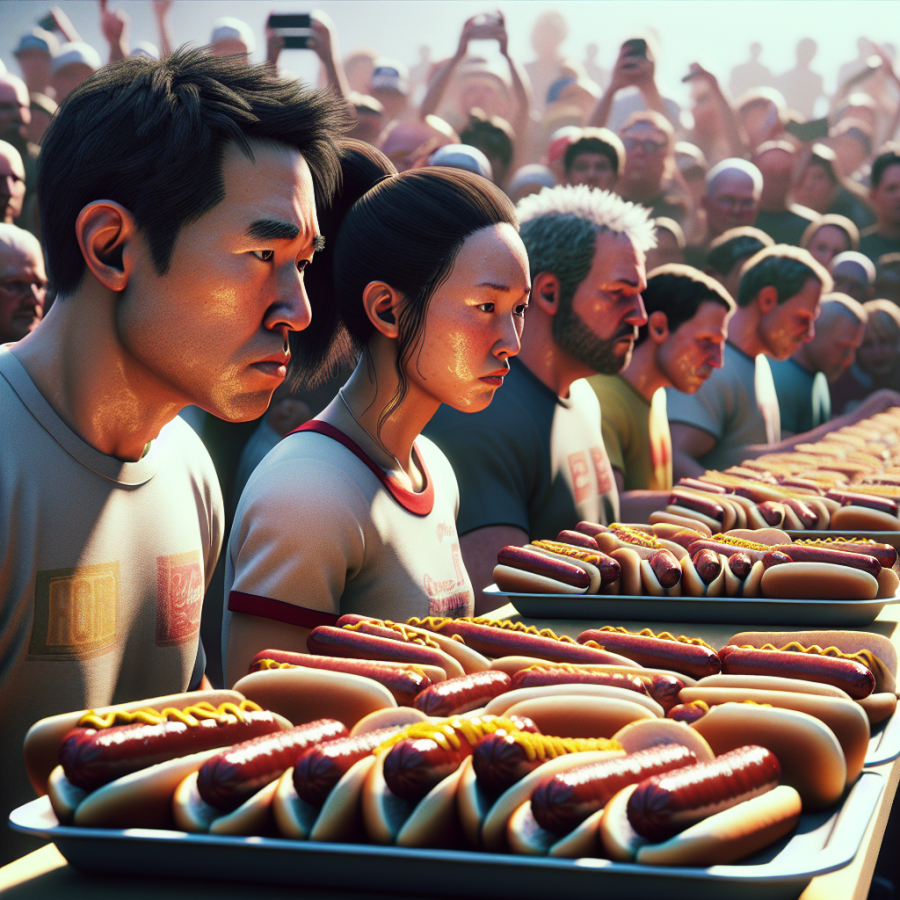The Culinary Coliseum: High-Stakes Contests in the World of Professional Gorging
Welcome to The Culinary Coliseum, an arena where intense rivalries heat up not over a flame but over plates piled high with gastronomic challenges. This sphere of competitive eating attracts Gastro Gladiators from around the world, each eager to claim a crown in the most stomach-stretching, jaw-dropping food contests known to man.
**Training and Techniques**
Much like any elite athlete, competitive eaters, or 'gurgitators', follow rigorous training regimens. They condition their bodies to accommodate extraordinary quantities of food by constantly stretching their stomachs with large volumes of water, fruits, and fibrous vegetables. Techniques vary from one competitor to another, with some focusing on speed and others on steadily maintaining a pace that maximizes intake over a set period. Strategies for specific foods are also developed, from dunking buns in water to reduce chewing time during hot dog contests, to devising methods to quickly separate meat from bone in wing eating championships.
**Major League Munching**
The epicenter of this appetite-driven sport is the array of major league eating competitions that dot the calendar annually. Events like Nathan’s Famous Fourth of July Hot Dog Eating Contest are broadcast internationally, drawing crowds in the thousands and viewers in the millions. Competitors face off in a 10-minute display of sheer willpower and capacity, downing dozens of hot dogs and buns (HDBs) as the world watches. Prizes for such events aren't merely a pat on the back; winners can expect to take home large cash prizes, sponsorships, and the honor of a title that can lead to public appearances and television spots.
**Variety is the Spice of Life… and Competition**
It's not only about hot dogs and burgers; professional gorging spans a smorgasbord of culinary challenges. From pies to pickles, chicken wings to pancakes, and oysters to ice cream, each contest presents its own set of rules and difficulties. While all demand volume and speed, some add the extra twist of spicy, sweet, or particularly challenging textures. The variety ensures a wide array of skills are tested and keeps both competitors and audiences hungry for more.
**Nutrition and Health: A Balancing Act**
Maintaining one's health is a top priority for these athletes. Despite what might be seen on the stage, professional eaters often lead lifestyles focused on balanced nutrition and fitness.
Read also:
Soccer Stars Who Made Their Mark on Liverpool FC
Training and Techniques: The Secrets Behind Competitive Eaters’ Success
Competitive eating is as much a sport as it is a spectacle, with participants pushing the limits of their stomachs to devour large quantities of food in a short amount of time. However, what appears to be a simple eat-and-repeat strategy on the surface is actually underpinned by rigorous training and a variety of techniques honed by the gastro gladiators of the competitive eating world.
The first step in a competitive eater's training regimen typically involves increasing stomach capacity. This is achieved by various methods such as drinking large volumes of water in a short time to stretch the stomach, or consuming hefty amounts of low-calorie, high-volume foods like watermelon and popcorn. These exercises are not unlike a marathon runner gradually increasing their mileage before a race, as they prepare their body to handle the stress of the event.
Some competitors also train by eating large meals and then fasting to help their stomachs recover and expand. This practice requires careful timing to avoid adverse health effects, and should only be attempted by those who have a thorough understanding of their body's limits and responses.
Technique is another crucial component of success in competitive eating. Professional eaters often develop their own unique styles of food manipulation and consumption. For example, the "Solomon Technique" involves breaking burgers or sandwiches into halves or quarters to make them easier to eat quickly, while the "Kobayashi Shake," popularized by the famed Takeru Kobayashi, helps compact the food in the stomach, creating more room and reducing the time spent chewing.
Breathing patterns and eating rhythm can also affect a competitor's speed and efficiency. Many successful eaters have mastered the ability to synchronize their breathing with their swallowing, taking quick breaths in between bites to maintain oxygen levels without disrupting their flow.
Beyond the mechanical aspects of eating, mental preparation is equally important. Competitive eaters must train their minds to ignore the signals of fullness and discomfort, often employing visualization techniques and positive self-talk to maintain their focus and composure during events.
To avoid choking, a significant hazard in this sport, competitors learn special chewing techniques and often practice with foods that pose a similar risk during training to improve their safety and confidence.
Furthermore, maintaining overall physical fitness outside of eating is essential for many competitive eaters, contrary to what one might expect.




